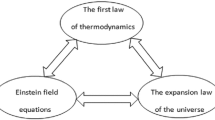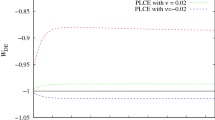Abstract
The aim here is to provide a set of equations for cosmology in terms of information and thermodynamical parameters. The method we implement in order to describe the universe is a development of Padmanabhan’s approach which is based on the fact that emergence of the cosmic space is provided by the evolution of the cosmic time. In this line we obtain the Friedmann equation or its equivalent the conservation law in terms of information by the implementation of Landauer’s principle or in other words the information loss/production rate. Hence, a self consistent description of the universe is provided in terms of thermodynamical parameters. This is due to the fact that in this work the role of information which is the most important actor of all times, has stepped in to cosmology. We provide a picture of the emergent cosmology merely based on the information theory. In addition, we introduce a novel entropy on the horizon, which can also generalize Bekenstein–Hawking entropy for the asymptotic holographic principle.
Similar content being viewed by others
Notes
The cosmic space volume is an evolutionary volume in respect to the cosmic time. This statement works only if the CMB is observed homogeneous and isotropic. As long as the CMB is proved to be homogeneous and isotropic for the geodesic observer, the respected time is the cosmic time. Note that the evolution of the cosmic space regarding the cosmic time may be subject to authors.
For simplicity, the natural units \(k_{{B}}=c=\hbar =1\) are used throughout this section.
References
Sakharov, A.D.: Sov. Phys. Dokl. 12, 1040 (1968) [Sakharov, A.D.: Gen. Relativ. Gravit. 32, 365 (2000)]
Jacobson, T.: Phys. Rev. Lett. 75, 1260 (1995). arXiv:gr-qc/9504004
Unruh, W.G.: Phys. Rev. D 14, 870 (1976)
Verlinde, E.: J. High Energy Phys. 4, 029 (2011).arXiv:1001.0785
Padmanabhan, T.: Mod. Phys. Lett. 25, 1129 (2010).arXiv:0912.3165
Padmanabhan, T.: arXiv:1206.4916
Padmanabhan, T.: Res. Astron. Astrophys. 12, 891 (2012).arXiv:1207.0505
Padmanabhan, T.: Class. Quantum Gravity 21, 4485 (2004). arXiv:gr-qc/0308070
Sheykhi, A.: Phys. Rev. D 87, 061501 (2013).arXiv:1304.3054
Bak, D., Rey, S.J.: Class. Quantum Gravity 17, L83 (2000). arXiv:hep-th/9902173
Cai, R.G., Kim, S.P.: J. High Energy Phys. 02, 050 (2005). arXiv:hep-th/0501055
Yang, K., Liu, Y.X., Wang, Y.Q.: Phys. Rev. D 86, 104013 (2012). arXiv:1207.3515 [hep-th]
Eune, M., Kim, W.: Phys. Rev. D 88, 067303 (2013).arXiv:1305.6688v2
Hashemi, M., Jalalzadeh, S., Vasheghani Farahani, S.: Gen. Relativ. Gravit. 47, 53 (2015). arXiv:1308.2383 [gr-qc]
Hu, Y.P.: Phys. Lett. B 701, 269 (2011).arXiv:1007.4044v3
Farag Ali, A.: Phys. Lett. B 732, 335 (2014).arXiv:1310.1790
Chang-Young, E., Lee, D.: J. High Energy Phys. 04, 125 (2014).arXiv:1309.3084
Ai, W.Y., Chen, H., Hu, X.R., Deng, J.B.: Gen. Relativ. Gravit. 46, 1680 (2014).arXiv:1309.1857
Heydarzade, Y., Hadi, H., Darabi, F., Sheykhi, A.: arXiv:1506.0238
Cai, R.G.: J. High Energy Phys. 11, 016 (2012).arXiv:1207.0622
Yuan, F.F., Huang, Y.C.: arXiv:1304.7949
Ai, W.Y., Chen, H., Hu, X.R., Deng, J.B.: Phys. Rev. D 88, 084019 (2013).arXiv:1307.2480
Yang, K., Liu, Y.X., Wang, Y.Q.: Phys. Rev. D 86, 104013 (2012).arXiv:1207.3515
Tu, F.Q., Chen, Y.X.: J. Cosmo. Astron. Phys. 05, 024 (2013)
Ling, Y., Pan, W.J.: Phys. Rev. D 88, 043518 (2013).arXiv:1304.0220
Sheykhi, A., Dehghani, M.H., Hosseini, S.E.: Phys. Lett. B 726, 23 (2013)
Padmanabhan, T.: Phys. Rev. D 81, 124040 (2010).arXiv:1003.5665
Padmanabhan, T.: Phys. Rev. D 83, 044048 (2011).arXiv:1012.0119
Padmanabhan, T.: Ret. Prog. Phys. 73, 046901 (2010).arXiv:0911.5004 [gr-qc]
Dowker, F.: arXiv:1405.3492 [gr-qc]
Padmanabhan, T.: Int. J. Mod. Phys. D 17, 591 (2008)
Szilard, L.: Zeitschrift fur Physik 53, 840 (1929)
Leff, H., Rex, A.F.: Maxwell’s Daemon 2: Entropy, Classical and Quantum Information, Computing, 2nd edn. Institute of Physics, London (2003)
Cpek, V., Sheehan, D.P.: Challenges to the Second Law of Thermodynamics: Theory and Experiment. Springer, Netherlands (2005)
Landauer, R.: IBM J. Res. Dev. 5, 183 (1961)
Leff, H.S., Rex, A.: Maxwell’s Demon: Entropy, Information, Computing, vol. 148. Princeton Press, Princeton, NJ (2003)
Sagawa, T.: Thermodynamics of Information Processing in Small Systems. Springer, New York (2012)
Duncan, T.L., Semura, J.S.: Found. Phys. 37, 1767 (2007). arXiv:hep-th/0703235
Duncan, T.L., Semura, J.S.: Entropy 06, 21 (2004). arXiv:hep-th/0501014
Misner, C.W., Sharp, D.H.: Phys. Rev. 136, B571 (1964)
Padmanabhan, T.: Gen. Relativ. Gravit. 46, 1673 (2014). arXiv:1312.3253 [gr-qc]
Bousso, R.: arXiv:hep-th/0205177
Hayward, S.A.: Class. Quantum Gravity 15, 3147 (1998). arXiv:gr-qc/9710089
Hayward, S.A., Di Criscienzo, R., Vanzo, L., Nadalini, M., Zerbini, S.: Class. Quantum Gravity 26, 062001 (2009).arXiv:0806.0014
Helou, A.: arXiv:1502.04235
Author information
Authors and Affiliations
Corresponding author
Appendix
Appendix
It is worth investigating other proposals fron f extracted from Eq. (4) in terms of the Landauer entropy (20). In this line after checking Landauer entropy for other proposals it will be seen that the chosen proposal of the present study (10) is indeed reasonable. We hope that the last degree of freedom in the dynamical emergent equation [choosing f in Eq. (4)] eliminates H from Eq. (20). Note that the existence of H in Eq. (20) puts us in a weak position for issuing an informational interpretation for the emergent cosmological Eqs. (21) and (22).
Equation (1) was proposed by Padmanabhan. He assumed the hubble horizon (\(R_{\mathrm{H}}=H^{-1}\)) to be the boundary of the universe. Therefore, the area and volume of the universe would be expressed as
The temperature corresponding to the horizon is assumed \(T_H=H/2\pi \). By calculating \(N_{\texttt {sur}}\) and \(N_{\texttt {bulk}}\) as defined in the Eq. (2) and its preceding paragraph, we have
Now by substituting these parameters into the Landauer entropy (20) we have
Unluckily H remains in the Equation disabling a robust thermodynamical interpretation of Landauer–Padmanabhan entropy.
Shyekhi’s Proposal is Eq. (5). He generalized the boundary of the universe to the apparent horizon and provided a general expression for the curvature of the universe. The area and volume for the universe is as of Shyekhi’s Proposal
The Kodama–Hayward temperature of the apparent horizon is assumed to be in the form \(T=1/2\pi R_{\mathrm{A}}\). Similar to Landauer–Padmanabhan entropy we should calculate \(N_{\texttt {sur}}\) and \(N_{\texttt {bulk}}\) as defined in Eq. (2) and its preceding paragraph
resulting in
It is not surprising that H still exists. We know that by substituting \(R_{\mathrm{A}}=H^{-1}\) in Eq. (37) one could reach Eq. (34). The informational interpretation of this entropy is unclear.
Another extension of Padmanabhan’s approach hs been provided by Yang et al. [12]. Their proposal [Eq. (7)] calculates the Raychaudhuri’s equation for an arbitrary dimension. For simplicity we focus on the 3 + 1 dimension universe. Their assumptions for the horizon radius and its temperature is similar to Padmanabhan’s approach, see equations (32 and 33). In 3 + 1 dimensions, the auxiliary parameters \(\alpha \) and K [12] are expressed by
Another auxilary parameter \(\tilde{\alpha }\) is the new degree of freedom in the Yang’s proposal which meets Padmanabhan’s proposal if\(\tilde{\alpha }\) equals zero. Note that for consistency [see Eq. (4)] we have the constant \(L_p^2\) is taken to the RHS of Eq. (7)
where \(f_{\texttt {Padmanabhan}}\) is Padmanbhan’s proposal (1). Yang’s proposal is reduced to the Padmanabhan’s suggestion if \(\tilde{\alpha }=0\). By substituting Eqs. (32), (33) and (38) into the Eq. (39) we have
Equation 40 is not directly based on only thermodynamic parameters.
Eune et al. propsed another propsal by calculating the volume differently. In brief their proposal is described as
where \(f_k\) is defined by Eq. (9). Except the definition of volume in their approach (and their proposal) other assumptions are the same as of sheykhi’s proposal. The entropy would be
Note that in this appendix the compatibility check between the Landauer entropy proposed in this work [Eq. (20)] with other dynamical emergent equations (Eq. 4) has been carried out. However, other potential proposals for Landauer entropy may provide an expression based on only thermodynamic parameters.
Rights and permissions
About this article
Cite this article
Hashemi, M., Jalalzadeh, S. & Vasheghani Farahani, S. The laws of thermodynamics and information for emergent cosmology. Gen Relativ Gravit 47, 139 (2015). https://doi.org/10.1007/s10714-015-1971-8
Received:
Accepted:
Published:
DOI: https://doi.org/10.1007/s10714-015-1971-8




